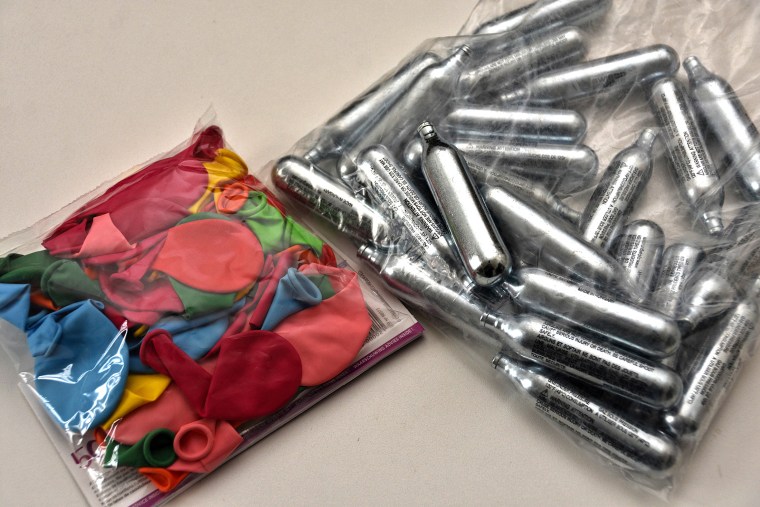Recreational use of nitrous oxide — often referred to as whippets or laughing gas — left a 23-year-old with frostbite in his mouth and throat, according to a report of the man’s case published Wednesday in the New England Journal of Medicine.
Recreational nitrous oxide use has been on the rise in recent years: Data from America’s Poison Centers shows a nearly 60% increase in reports of intentional exposure to the drug from 2023 to 2024. The Food and Drug Administration has issued several warnings advising people against inhaling nitrous oxide products, which are often marketed to be used to make whipped cream.
Frostbite occurs when ice crystals form in the skin and deeper tissues, damaging cells and disrupting blood flow. Dr. Michael Patrizio, associate director of acute care at the University of Virginia, said getting frostbite in the mouth and throat from inhaling nitrous oxide is rare, but not unheard of.
The patient told Patrizio that his painful swallowing and hoarseness started immediately after he inhaled nitrous oxide directly from a canister two days prior. White blotches — the frostbitten tissue — swelled on the roof of his mouth, uvula and throat.
“Had he not been forthcoming with that information, that probably wouldn’t have been something that crossed my mind,” said Patrizio, who saw the man at the campus’s outpatient clinic and was a co-author of the case report. “I would have thought a viral infection — mono, strep throat — or an STI in the throat.”
When a compressed gas expands, it can cool to as low as minus 40 degrees Fahrenheit — this is why compressed gas is used to cool refrigerators. Canisters of compressed nitrous oxide work in the same way. When the gas is released, it cools, sometimes drastically.
“This has the potential to cause frostbite,” Dr. Cara Borelli, an addiction medicine physician at Yale University, said in an email. Borelli wasn’t involved with the patient’s case.
Surgeons use compressed nitrous oxide to perform ablations, a procedure that uses extreme cold or heat to remove tissue.
“If you have someone using drugs in an uncontrolled setting, you may certainly be doing damage to tissue that you don’t want to be doing damage to,” said Dr. Jeffrey Ruwe, an emergency medicine physician at Cleveland Clinic who wasn’t involved with the man’s case.
Overall, cases of frostbite from nitrous oxide canisters are rare, though they are likely underreported, Patrizio said. More commonly than in the mouth and throat, illicit nitrous oxide use leads to frostbite burns on the thighs and hands, since people hold chilled canisters and fill balloons with the gas, which allows the gas to warm before people inhale it.

Frostbite can be serious — at least several people have required skin grafts and surgery due to nitrous oxide burns on their legs and hands — however, “that’s not really the risk people think of,” Patrizio said.
The more common risks of recreational nitrous oxide use include a ruptured lung, from inhaling the gas too deeply, and a lack of oxygen in the brain, he said. It can also cause vitamin deficiencies that can lead to potentially fatal neurological problems.
“Nitrous oxide inactivates vitamin B12, meaning that the body’s B12 does not function as it is supposed to,” Borelli said.
The body uses vitamin B12 to synthesize myelin, a substance made from fats and proteins that surrounds and insulates nerves. If this sheath breaks down, it can cause serious neurological issues. After chronic use, nitrous oxide can cause nervous system and brain changes that can progress from weakness and unsteadiness to paralysis.
“That’s very real,” Ruwe said.
Patrizio told his frostbitten patient to use over-the-counter pain medication, lidocaine and a steroid paste to reduce inflammation and swelling while his frostbite healed.
Ruwe said this may not be the case for everyone.
“Frostbite is very, very rare, but if inhaled directly from a higher-pressure tank, or if it causes airway swelling, it could be time-sensitive and potentially deadly,” he said.
